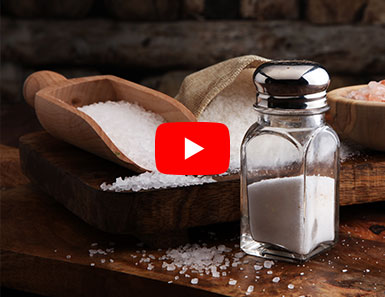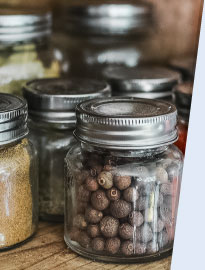Where Does the Average Canadian Get Salt From?
- 10% from foods naturally consumed
- 10-25% from the salt shaker
- 75% from processed foods and meals eaten away from home


 Learn how to choose healthier spices, condiments, and sauces
View Videos
Learn how to choose healthier spices, condiments, and sauces
View Videos
Why Reduce Salt?
Canadians eat more sodium than they need. Salt (sodium chloride) is the most common form of sodium in the diet. Having too much sodium in your diet is linked to high blood pressure and fluid retention. High blood pressure is a risk factor for heart disease.
Learn more about high blood pressure and heart disease »
To stay healthy, keep your sodium intake to
less than 2000 mg each day. One teaspoon of salt is about 2300 mg of sodium.
Learn how to make delicious and easy low sodium recipes »
What Foods Have Sodium?
Sodium in the diet comes from three main areas.
- Foods that you eat which naturally contain sodium.
- Salt added when cooking or at the table.
- Salt that is added to foods during commercial processing.
Examples of sodium in processed and restaurant foods
| Food | Portion | Sodium (mg) |
|---|
| Pepperoni pizza slice, large | 295 g | 1630 |
| Bacon & 2 eggs | 124 g | 929 |
| Big Mac | 208 g | 1020 |
| Fries, small | 70 g | 190 |
| Chicken caesar salad | 317 g | 1100 |
| Oven roasted sliced turkey meat sandwhich on whole wheat bread | 236 g | 1380 |
| Canned soup | 1 cup | 700 - 900
|
| Dill pickle | 1 | 600 |
Season Your Food Without Salt
Herbs and spices can make food tasty and flavourful without adding sodium. Blend these herb mixtures together and use them to season your food instead of salt.
Food flavouring recipe
Combine all ingredients. Store in an air-tight container or fill an empty seasoning jar with holes large enough for easy shaking.
- 4 tbsp basil
- 4 tbsp oregano
- 1 tbsp garlic powder
- 4 tsp marjoram
- 4 tsp onion powder
- 2 tsp dill
- 2 tsp sage
- 2 tsp rosemary
- 1 tsp ground black pepper
All-purpose flavouring
Combine all ingredients and store in glass shaker. Add a few grains of rice to prevent caking.
- 2 tsp garlic powder
- 1 tsp basil
- 1 tsp dill
- 1 tsp oregano
- 1 tsp powdered lemon rind
Herb mix
Combine all ingredients. Substitute other herbs as desired.
- 1 tsp ground cayenne
- 1 tsp garlic powder
- 1 tsp basil
- 1 tsp mace
- 1 tsp dried parsley
- 1 tsp thyme
- 1 tsp onion powder
- 1 tsp black pepper
- 1 tsp sage
Matching Herbs With Foods
Some herbs and spices can balance out the sweetness of fruits, others blend nicely with the savoury flavours of a soup or stew. Experiment with these spices or herbs the next time you make the following foods.
| Food | Spices or herbs |
|---|
| Bread | Caraway, marjoram, oregano, poppy seed, rosemary, thyme |
| Cheese | Basil, chervil, chives, curry, dill, fennel, garlic chives, marjoram, oregano, parsley, sage, thyme |
| Fruit | Anise, cinnamon, coriander, ginger, lemon verbena, mint, rose geranium, sweet cicely |
| Salads | Basil, borage, burnet, chives, French tarragon, garlic chives, parsley, sorrel These are best used fresh or added to salad dressing. Otherwise, use herb vinegars for extra flavour. |
| Soups | Bay, chervil, French tarragon, marjoram, parsley, savory, rosemary, fresh parsnip, celery stalk or celery root |
| Vegetables | Basil, burnet, chervil, chives, dill, French tarragon, marjoram, mint, parsley, pepper thyme |
| Fish | Chervil, dill, fennel, French tarragon, garlic, parsley, thyme |
| Beef | Bay, chives, cloves, cumin, garlic, hot pepper, marjoram, rosemary |
| Lamb | Garlic, marjoram, oregano, rosemary, thyme (make little slits in the lamb to be roasted and insert herbs) |
| Poultry | Garlic, oregano, rosemary, savory, sage |
| Pork | Coriander, cumin, garlic, ginger, hot pepper, pepper sage, savory thyme |
